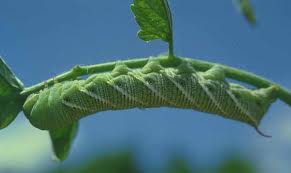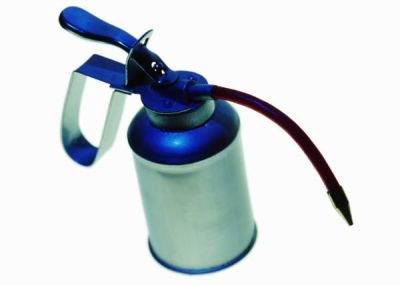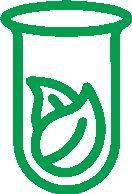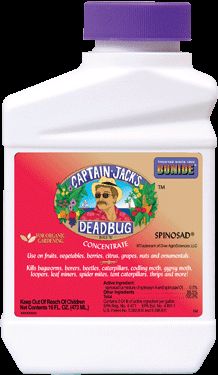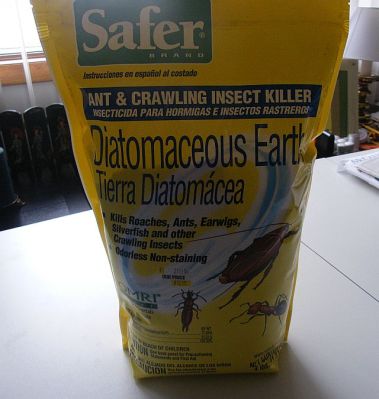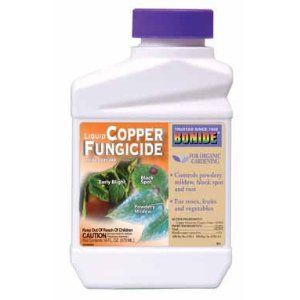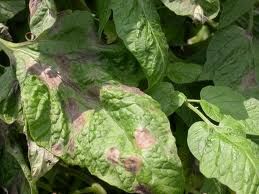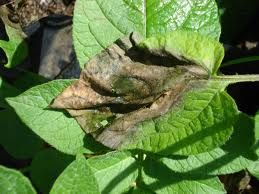Now that the Gardens are about to open for another wonderful season, there are a few things that I must say over again. This is all about BUGS AND BLIGHTS and controlling them. I was going to also include some material about what is really bugging me about the canning and preserving information on the internet, but I am working on a canning and preserving course and I want to wait until I am done with that before presenting the information learned to you.
Also, I wanted to talk about fertilizer and garden prep, but I have been getting so many questions about pest control that I decided to talk about this issue first. My next will have some information about garden preparation.
It is a good thing that people are thinking about bugs NOW. It is before the bugs come out that one needs to think about the damage they will do and how that damage can safely be controlled.
Some of these critters can and will eat anything. . .even a tobacco plant. . .
And they’ll do it mighty fast. . .
And not only will they eat up your garden quickly, they will leave millions of little ones behind to finish the job. . .
Or they will spread all types of contagion, like Blue Blight or even the dreaded Late Blight—the same disease that caused the Irish Potato Famine.
The problem is—what are the safest and most effective controls? (Is it just me, or are all those pictures of bugs so creepy that your skin CRAWLS???!? GOOD!
There’s a tremendous difference between spraying ornamental plants like roses and spraying a vegetable garden. The roses might be cut for decorative bouquets, but you and your family are going to eat the vegetables. It is essential that you make sure that there are no chemical residues left on the food. Be observant and read the labels—many insecticides are not labeled for use on vegetable gardens.
Of the insecticides that are labeled for use on vegetables, very few are labeled for use on every vegetable or fruit in the garden. Be sure the insecticide is labeled for use on the vegetable crop you plan to treat.
Also, make sure you understand the time that must elapse between the spraying of the garden and the harvesting of the veggies. This time varies according to what is being sprayed (or dusted on) the particular vegetable crop being treated. For example, time between treatment and harvest for carbaryl (Sevin) is 2 days on corn, 3 days on tomatoes, 7 days on Irish potatoes, and 14 days on turnips. Not understanding this could result in you serving chemically contaminated food to your family and friends. Please read all labels completely.
Of course, I am NOT suggesting that anyone use SEVIN in their garden at all. As I mentioned in a previous blog, SEVIN has not been proved entirely safe for use on vegetables and chemical-based controls may not work in the Community Gardens. First, there is the ever-present problem of “overspray,” where whatever it is you are spraying on your veggies winds up drifting over your neighbor’s garden. Many of us are organic gardeners and while we don’t care what you spray on your garden, we very much care about chemicals drifting over on the air currents and settling on our plants. Many of the more popular chemical garden sprays are useless in the Community Gardens anyway because they have been used so often and in such large quantities that the bugs have grown immune to them.
DON’T BOTHER WITH:
SEVIN (Carbaryl) or
MALATHION
These will not kill much of any of the garden pests in the Community Gardens, but they can contaminate your vegetables and leave residues that will make you sick. In fact, SEVIN does nothing at all to control Colorado Potato Beetles, Stink Bugs or Cucumber Beetles, which are the worst of the pests over there.
Also, ROTENONE, though derived from natural sources has been rendered ineffective due to overuse.
If you believe in better living through chemistry, there is a new class of chemicals that are SYNTHETIC Pyrethrins called PERMETHRINS, and these are being sold as sprays and dusts for vegetable gardens, but like their organic counterpart, Pyrethrin, overuse of PERMETHRINS can cause populations of flea beetles, spider mites, whiteflies and aphids to increase rapidly. And these little devils can do a tremendous amount of damage to leafy greens like spinach, collards, and kales. Also, PERMETHRINS cannot be sprayed on every single type of veggie, and they may leave behind undesirable residues. Please read the labels carefully.
If at all possible, what you SHOULD use are the organic controls. AND YES, they DO work, quite effectively in fact. Using these organic controls allowed us to harvest over 200 pounds of potatoes in 2012. YUP—200 pounds!
YOU SHOULD TRY:
Insecticidal Soaps –for control of aphids, whiteflies, mites and flea beetles. Either Concern or Safer Insecticidal Soap is a good choice.
Neem Oil—any brand is good. Neem controls many pests, including spider mites, flea beetles, cabbage worms, squash bugs, whiteflies and leafhoppers.
Bacillus thuringiensis (Bt) is great for controlling the caterpillar or worm form of many insects, and certain species of Bt (Bacillus thuringiensis var. tenebrionis) control the Colorado Potato Beetle as well. The kurstaki var. is sold as Thuricide or Dipel, and the tenebrionis var. is sold as Colorado Potato Beetle Beater. Bt Kurstaki is EXCELLENT for controlling earworms on corn or hornworms on tomatoes.
Spinosad, also known as Captain Jack’s Dead Bug Brew or Bulls’ Eye, is an excellent choice for controlling a large variety of vegetable garden pests, INCLUDING the Colorado Beetle, the Stink Bug and the Japanese Beetle. It is also an effective control for the Cucumber Beetle, which seems to eat virtually everything in the garden.
Pyrethrins—Natural insecticide derived from an African Daisy. Important to only use occasionally for the QUICK kill and “knock down” of infestations. Then revert to one of the other methods.
Now we come to DIATOMACEOUS EARTH (DE) , one of the very best organic controls for garden pests. Diatomaceous Earth is a naturally occurring, soft, sedimentary rock that is easily crumbled into a fine white powder. Different grades of DE have different particle sizes depending on its use. To humans, the powder has a mildly abrasive feel and is very light.
DE is made up of fossilized remains of diatoms, type of hard-shelled algae. It is used as a filtration aid, a mild abrasive in products including toothpaste and scrubbing powers (like Ajax or Comet), mechanical insecticides, absorbents for liquids, matting agents for coatings, a reinforcing filler in plastics and rubber, cat litter, activators in blood clotting agents. It is also a stabilizing component of dynamite and a thermal insulator. We are interested here in its use as a natural insecticide.
DE is used as an insecticide due to its drying properties. The fine powder absorbs the fats and waxes that make up the carapace of the insect’s bodies or exoskeletons (outer shell), causing the insect to dehydrate. Insects then die as a result of the water deficiency. This drying and abrasive property also works on worms, slugs and caterpillars. DE can be used alone but it is sometimes mixed with an attractant or other additives to increase its effectiveness. Medical-grade DE is sometimes used to de-worm livestock and humans. In order to be effective as an insecticide, diatomaceous earth must be a fine powder, with a mean particle size below 12 microns. For this reason, most insecticidal DE is “food grade,” that is to say, it is exactly the same as the type added to toothpastes. Pool filter DE may not work as effectively as it is not “food grade.” Also pool filter DE may contain additives like citric acid or other chemicals that make it unsuitable for garden use.
DE is an effective mechanical killer that no insects have a defense against. To humans, DE feels like talcum powder. To insects, however, the tiny particles are razor sharp and slice through their outer shells when they try to climb over it . This cutting open of their outer shell exposes their inner soft tissue to air and they dehydrate within 24-48 hours. If they bite into a plant covered with DE, it tears up their mouth and digestive systems. However, DE does not harm mammals at all. While DE is a death sentence for insects, it will not harm you or your pets. Since DE is not chemical in nature and works mechanically, pests cannot build resistance to it, unlike chemical pesticides. DE also offers the added benefit of supplying your soil with micronutrients and calcium as it breaks down. DE should be used only when you are sure that the weather will be dry for a couple days.
I usually mix my DE with Captain Jack Deadbug Brew Dust, which makes a very effective killer for Colorado Potato Beetles, Cucumber Beetles and Stink Bugs.
A SPECIAL NOTE (ONCE AGAIN) ABOUT THE IMPORTANCE OF FUNGICIDES. . .
Blights, or fungal plant diseases are a real problem in the Community Gardens. If you have had seasons of little to no success with squash, melons or cucumbers, then blame it on the blight problem. The trouble is that now, we have a much worse blight to worry about.
In a previous blog, I mentioned that the LATE BLIGHT has been detected in Pennsylvania, not far from here. Late Blight is the very same plant disease that caused the Irish Potato Famine, and it affects nearly all plants in the genus Solanaceae. Solanaceae are a family of flowering plants that includes a number of important edible agricultural crops. Although many species are poisonous, some are edible and healthy. The family is also informally known as the nightshade family.
The family includes mandrake, deadly nightshade, tomatillo , cape gooseberry, chili pepper, bell pepper, potato, tomato, eggplant, and petunia. All of these are technically nightshades.
Yeah! Petunias—Who Knew????!?
Anyway, many members of the Solanaceae family are used by humans as important sources of food, spice and medicine. One of the things that these plants have in common is that they are all predated by the same type of bugs. For example, the Colorado Beetle will eat Tomaotes, Tomatillos, Potatoes, certain Peppers and eggplants. But the important thing to remember now is that the SAME BLIGHTS will also trouble and destroy members of this plant family.
Late Blight is caused by the fungus Phytophthora infestans. It can infect and destroy the leaves, stems, fruits, and tubers of plants in the nightshade family, including potatoes, tomatoes and eggplants. Before the disease appeared in Ireland it caused a devastating epidemic in the early 1840s in the northeastern United States. P. infestans was probably introduced to the United States from central Mexico, which is its center of origin. After appearing in North America and Europe during the 1840s, the disease spread throughout most of the rest of the world during subsequent decades and had a worldwide distribution by the beginning of the twentieth century. And as I wrote in a previous blog, Late Blight HAS BEEN DETECTED IN CENTRAL PENNSYLVANIA. So folks, it is here.
Late Blight Fungus spreads from plant to plant in the air, through the splashing of rain and by direct contact. An entire garden can be destroyed by Late Blight in DAYS! Severe late blight epidemics occur under conditions of high moisture and moderate temperatures (60 to 80 degrees). This means that the danger is HIGHEST in late spring—April, May and early June. Infected plants MUST BE ENTIRELY REMOVED FROM THE GARDEN—you cannot save any part of the plant and the plant should NOT BE ADDED to compost piles.
It is therefore ESSENTIAL that any tomatoes, potatoes, eggplants, or peppers planted in April and May be promptly treated with fungicides, and that use of fungicides continue on a regular basis throughout the season. I prefer to use the organic fungicide shown above, but any one that is intended for use in vegetable gardens is okay.
You also need to know that a very common blight at the Community Gardens is Blue Blight or Powdery Mildew, which appears as bluish or whitish spots on the leaves of cucumbers and squash. This blight may also affect tomatoes as well. I have also seen Cucumber Blight and Black Rot in the Gardens. These types of fungus live in the soil and erupt with excessive rain or overwatering. Fungicide use and careful watering (not watering in the late evening when plants will remain wet, for example) will control these types of blights as well.
Here is an illustration of Late Blight on a Tomato:
and on a Potato
You can read more information about Late Blight here
In the next post, I will give more information on preserving the harvest, such as recommendations for where to obtain canning and dehydrating supplies, and what type of supplies are best for use. I am in the middle of taking a Food Preservation Course offered by the National Center for Home Food Preservation, and I want to finish the course first.
Hopefully the Gardens will be open by the time of my next post. See you there.


